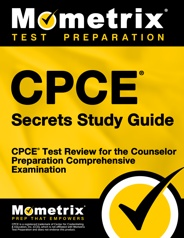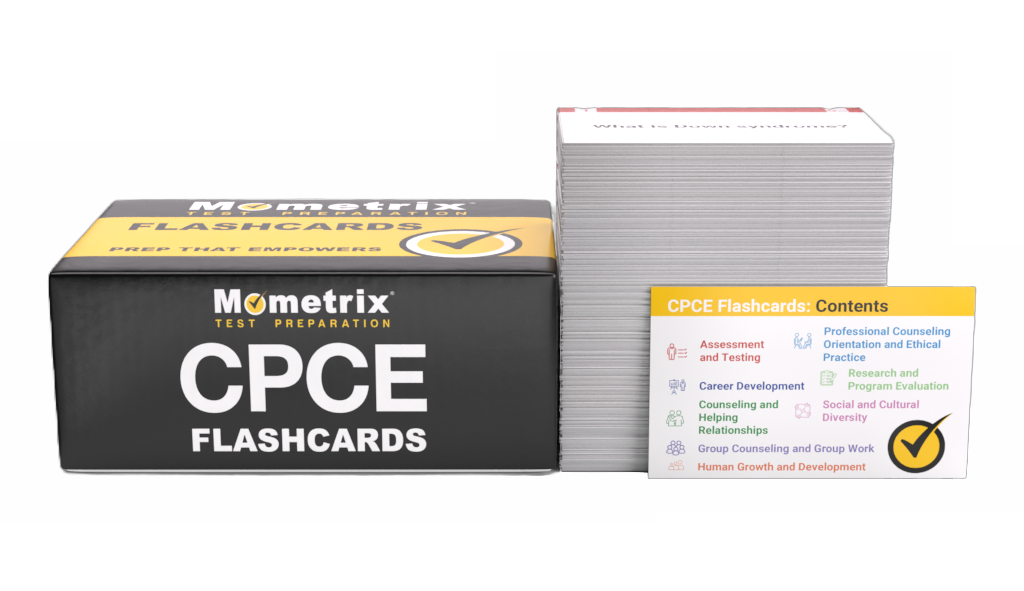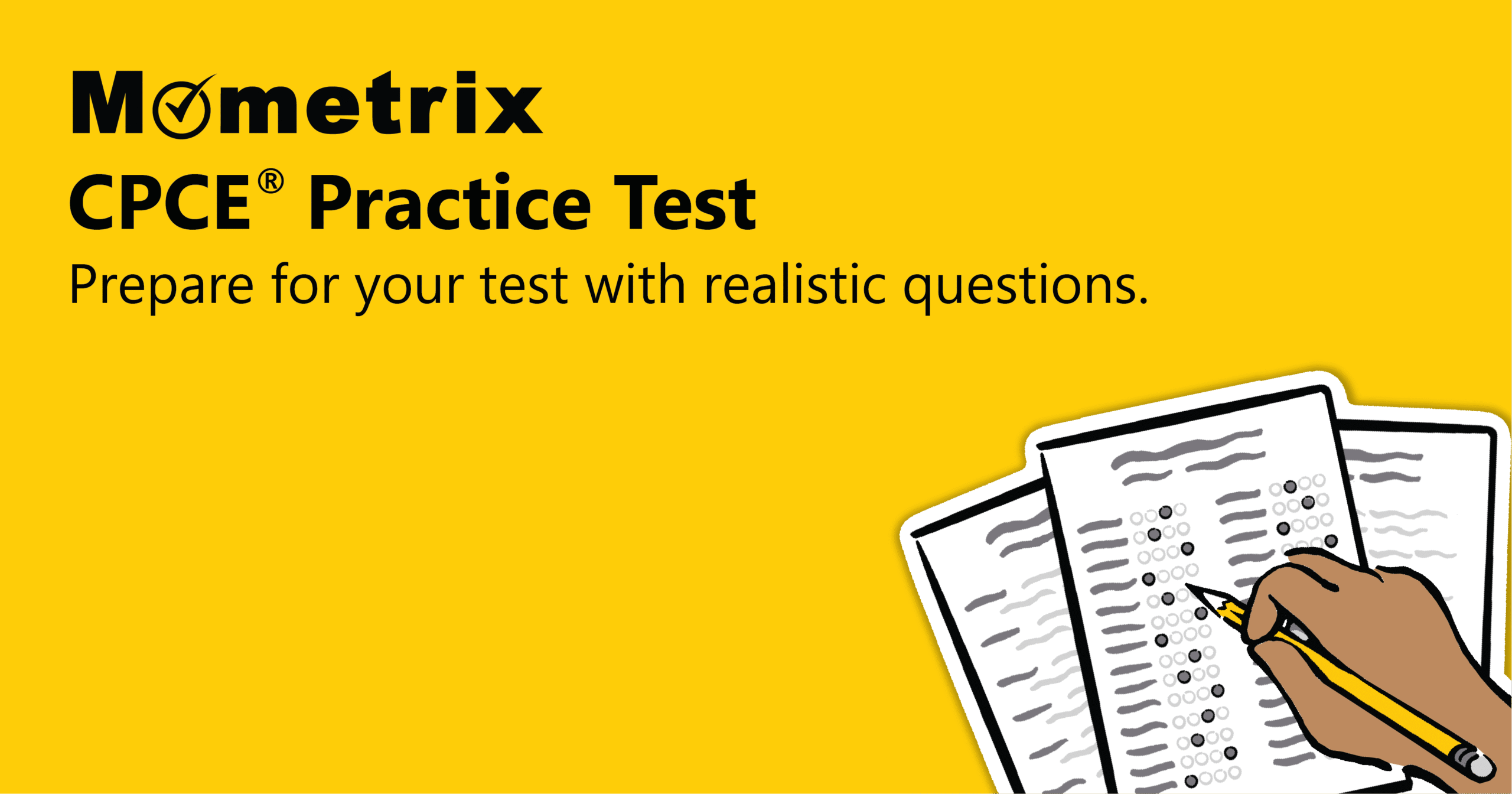The Counselor Preparation Comprehensive Exam (CPCE®) is required by hundreds of universities and colleges across the United States for students in graduate level counseling or education programs. It measures a student’s competence across a range of foundational concepts and knowledge related to counseling as a profession.
Click “Start Test” to take a free CPCE practice test!
CPCE Question of the Day
CPCE Exam Outline
The CPCE contains 160 multiple-choice questions, though only 136 of the questions will count toward your final score. You will be given 3 hours and 45 minutes to complete the exam.
Effective January 2024, 50% of the questions on the exam contain 3 answer choices, with the other 50% containing the usual 4 answer choices.
The exam spans eight common core areas that are all highly relevant to the field of counseling. There are 20 questions in each section.
- Professional Counseling Orientation and Ethical Practice
These questions assess your knowledge of the history and philosophy of the counseling profession, the role of the counselor advocating on behalf of the profession, current labor market information, technology’s impact on the counseling profession, and self-care strategies appropriate to the counselor role. - Social and Cultural Diversity
These questions assess your knowledge of theories and models of multicultural counseling, effects of power and privilege for counselors and clients, help-seeking behaviors of diverse clients, and strategies for identifying and eliminating barriers and prejudices. - Human Growth and Development
These questions assess your knowledge of theories of learning, theories of abnormal personality development, effects of crises, etiology of addictions and addictive behaviors, and differing abilities and strategies for differentiated interventions. - Career Development
These questions assess your knowledge of strategies for career development program planning, models of career development, ethical and culturally relevant strategies for addressing career development, and facilitating client skill development for career planning and management. - Counseling and Helping Relationships
These questions assess your knowledge of counseling theories and models, conceptualizing clients using a systems approach, processes for aiding students in developing a personal model of counseling, and case conceptualization skills. - Group Counseling and Group Work
These questions assess your knowledge of designing and facilitating groups, therapeutic factors, dynamics associated with group process, and approaches to group formation. - Assessment and Testing
These questions assess your knowledge of reliability and validity in assessments, procedures for identifying trauma and abuse, assessing risk of aggression or danger, environmental assessments, and preparing for initial assessment meetings - Research and Program Evaluation
These questions assess your knowledge of evidence-based counseling practices, mixed research methods, analysis of data in counseling, statistical methods used in conducting research, and needs assessments.
Check out Mometrix's CPCE Study Guide
Get practice questions, video tutorials, and detailed study lessons
Get Your Study Guide
Top 5 Most Challenging CPCE Questions
Now that you know more about the exam, try your hand at some targeted practice!
Over the last year, we’ve compiled the data from about 6,000 test-takers who tried their hand at the practice test at the top of this page. According to the data, around 70%-80% of people answered these five questions incorrectly.
Answer each question and read through the answer explanation, whether you got the answer right or wrong. This will help you ensure you’ve got the topic mastered.
Whether you struggled with these questions or aced them on your first try, be sure to take the full practice test to get a better idea of how prepared you really are!
1. Consider the following scenario:
Dr. Stanwyck has found a significant difference in the mean test scores of his two student groups. He has also found a significant interaction between their scores. He subsequently tested for significance on a second dependent variable as well. Now he wants to make one more analysis based on the information he has obtained related to the first dependent variable he tested—that of self-efficacy. In pretesting, he noticed that the college seniors in each group had higher average scores in self-efficacy than the college juniors in each group. Therefore, he now adjusts the groups’ scores statistically to control for these initial differences before he compares his two test groups.
What kind of test is Dr. Stanwyck using?
2. John Krumboltz is to Albert Bandura as:
3. Counselors who practice MI:
4. Obsessive-compulsive personality disorder is characterized by:
5. Disadvantages of closed-ended questions include all of the following EXCEPT:
Registration
You have two options for taking this exam. One option is to take it on campus at your school. The second option is to take it at an approved Pearson VUE facility. The process and fees are different depending on which option you choose.
If you choose to take it on campus, you will register at your school. Call your program director or advisor to schedule an appointment. The dates and times available for the test will depend on what your school offers.
The exam fee is $75, which is less expensive than the Pearson VUE option; however, you won’t be guaranteed a standardized testing experience. It will be administered on a computer, using a secure internet browser, but beyond that, testing conditions will be determined by your school.
When scheduling your appointment, make sure to ask the following questions:
- How much time will I have for each section?
- How soon will I find out my score?
- What do I need to bring with me?
- What form of ID will you accept?
- Will there be any scheduled breaks during the exam?
- What is the minimum score required to pass?
If you choose to take it at an authorized Pearson VUE facility, you can schedule your appointment online or by phone with the Center for Credentialing and Education. The fee will be $150, which will assure a standardized testing experience.
That means you can be sure that the testing center will be quiet, free of distraction, and that no issues will come up during the test. You will still take the exam on a computer, but rather than an internet-based test, it will be a test on that computer so there won’t be a concern about spotty internet connection.
How the Test is Scored
The maximum score you could receive is a 136—the total number of scored questions across all eight core areas. Your score on the test is a “raw” score directly representing the number of questions you answered correctly.
There is no universal criteria for passing the exam, as the minimum requirement is set independently by each university. In general, the minimum will likely be somewhere between 62% and 65% correct (so 85 to 89 out of 136).
However, in some circumstances, the minimum could be as high as 75% (102 out of 136) so you definitely need to ask rather than risk aiming for a score that is lower than what you need.

CPCE Online Prep Course
If you want to be fully prepared, Mometrix offers an online CPCE prep course designed to give you everything you need to succeed!
Here’s what you’ll find in the CPCE course:
Everyone learns differently, so we’ve tailored the CPCE online prep course to ensure every learner has what they need to prepare for the CPCE exam.
Click below to check it out!
Check out Mometrix's CPCE Flashcards
Get complex subjects broken down into easily understandable concepts
Get Your Flashcards
FAQs
Q
How many questions are on the CPCE?
A
There are 160 questions on the CPCE, though 24 of those questions will not count toward your final score.
Q
How long is the exam?
A
The CPCE is timed at 3 hours and 45 minutes.
Q
What is a passing score?
A
There is no set passing score for the CPCE, as each school will set their own. However, a score of 90 is generally considered a passing score.
Q
How much does the CPCE cost?
A
The CPCE costs $150 for the Pearson-VUE-administered test and $75 for the school-administered test.
CPCE is a registered trademark of Center for Credentialing & Education, Inc. (CCE), which is not affiliated with Mometrix Test Preparation and does not endorse this page.




